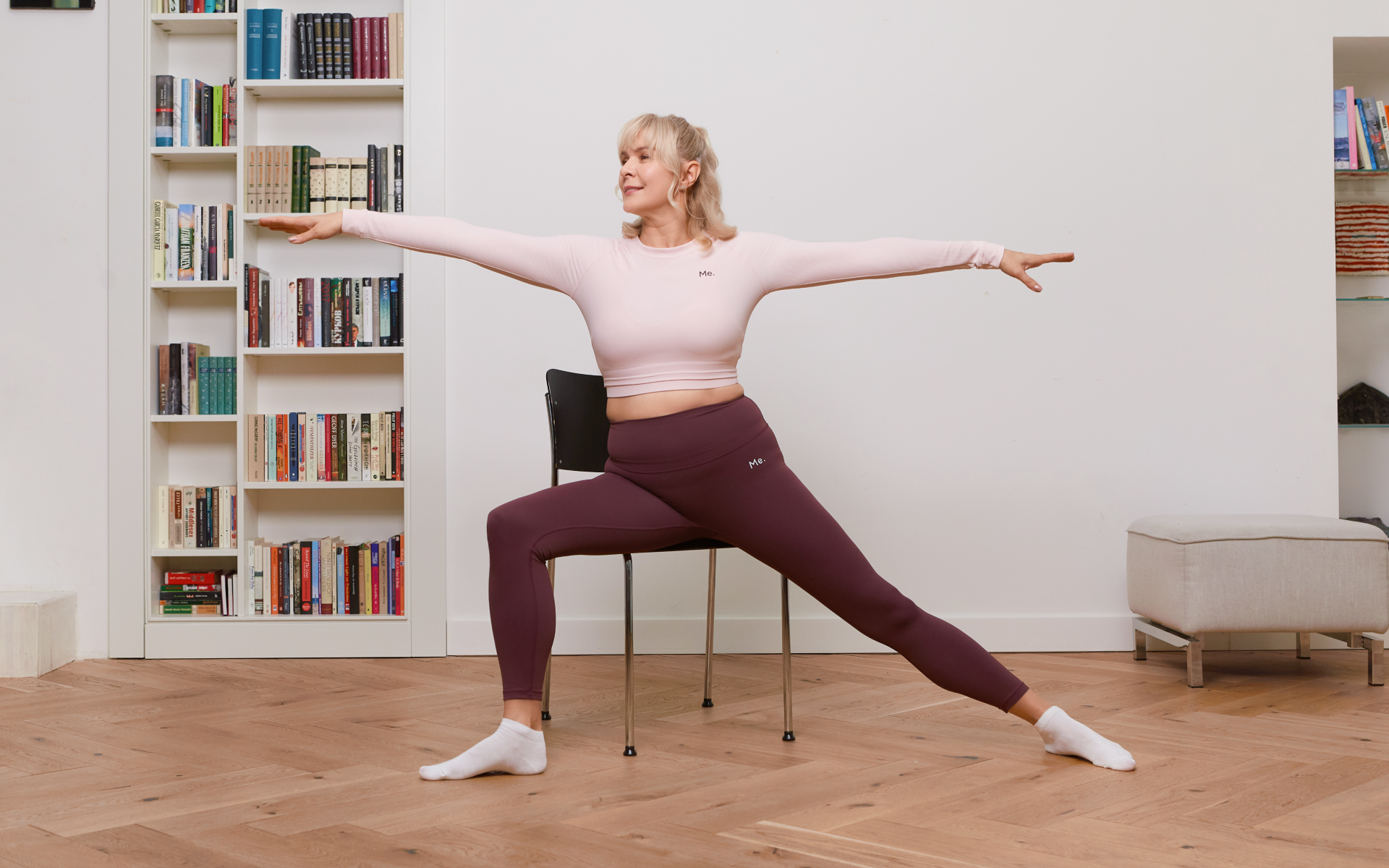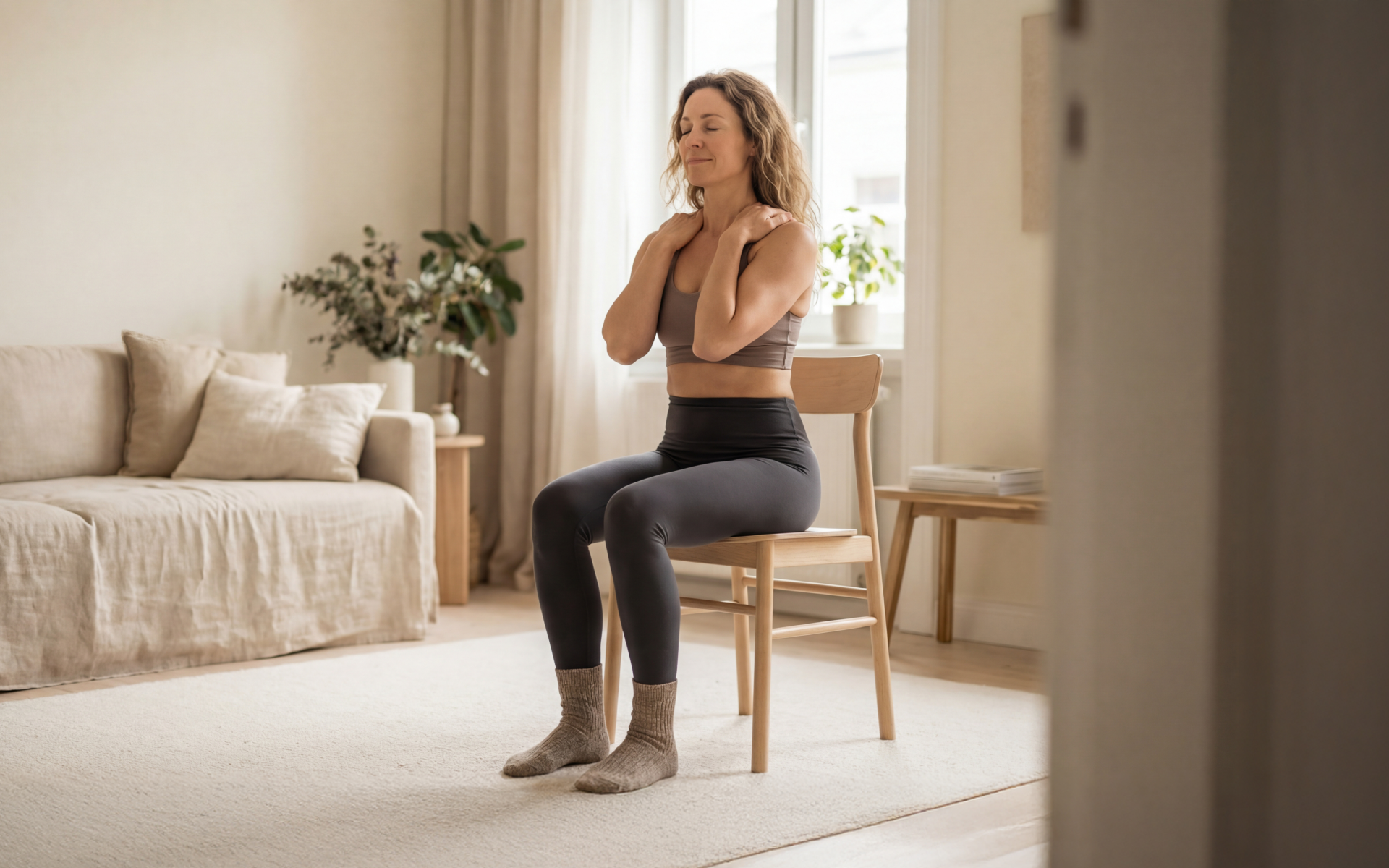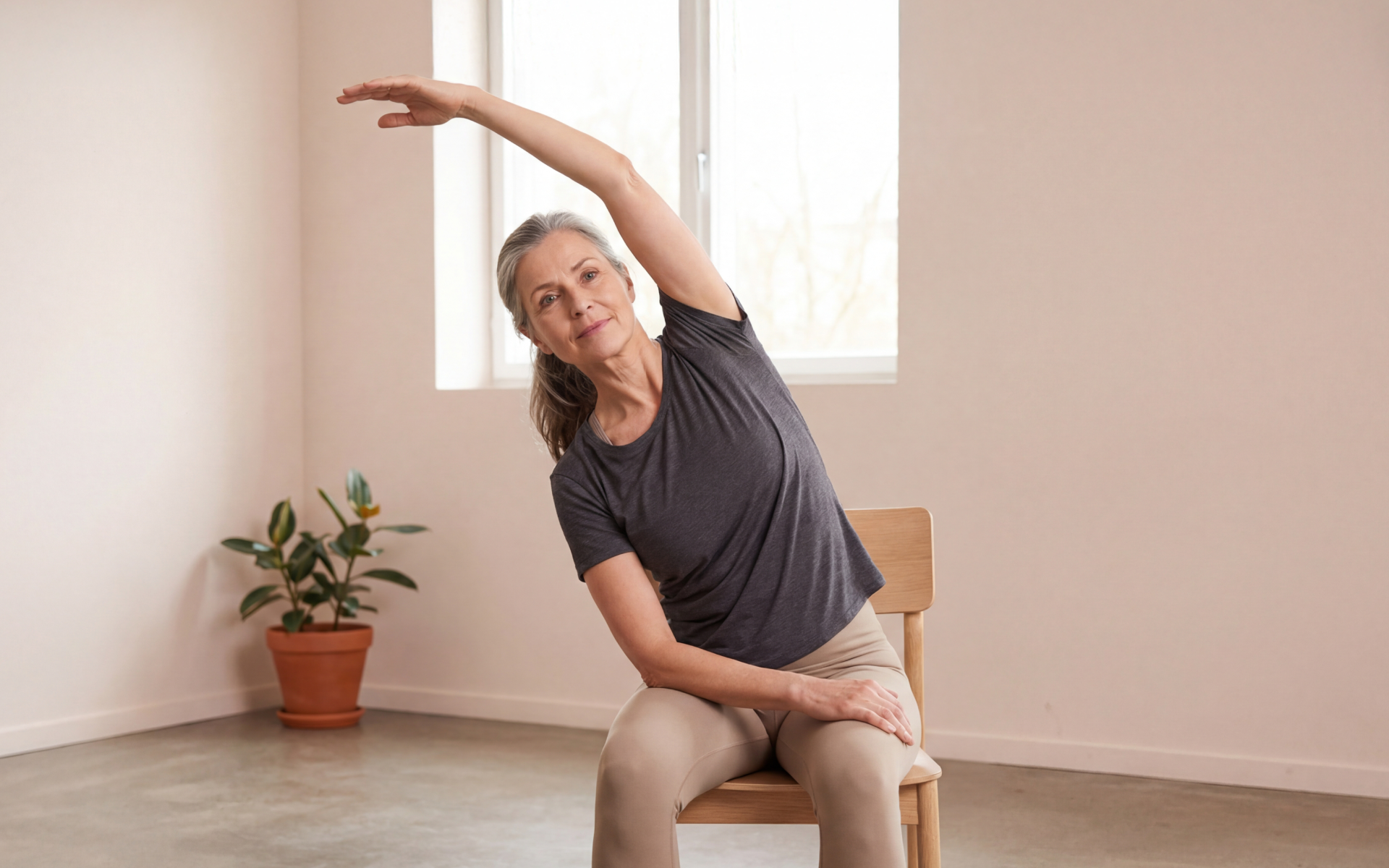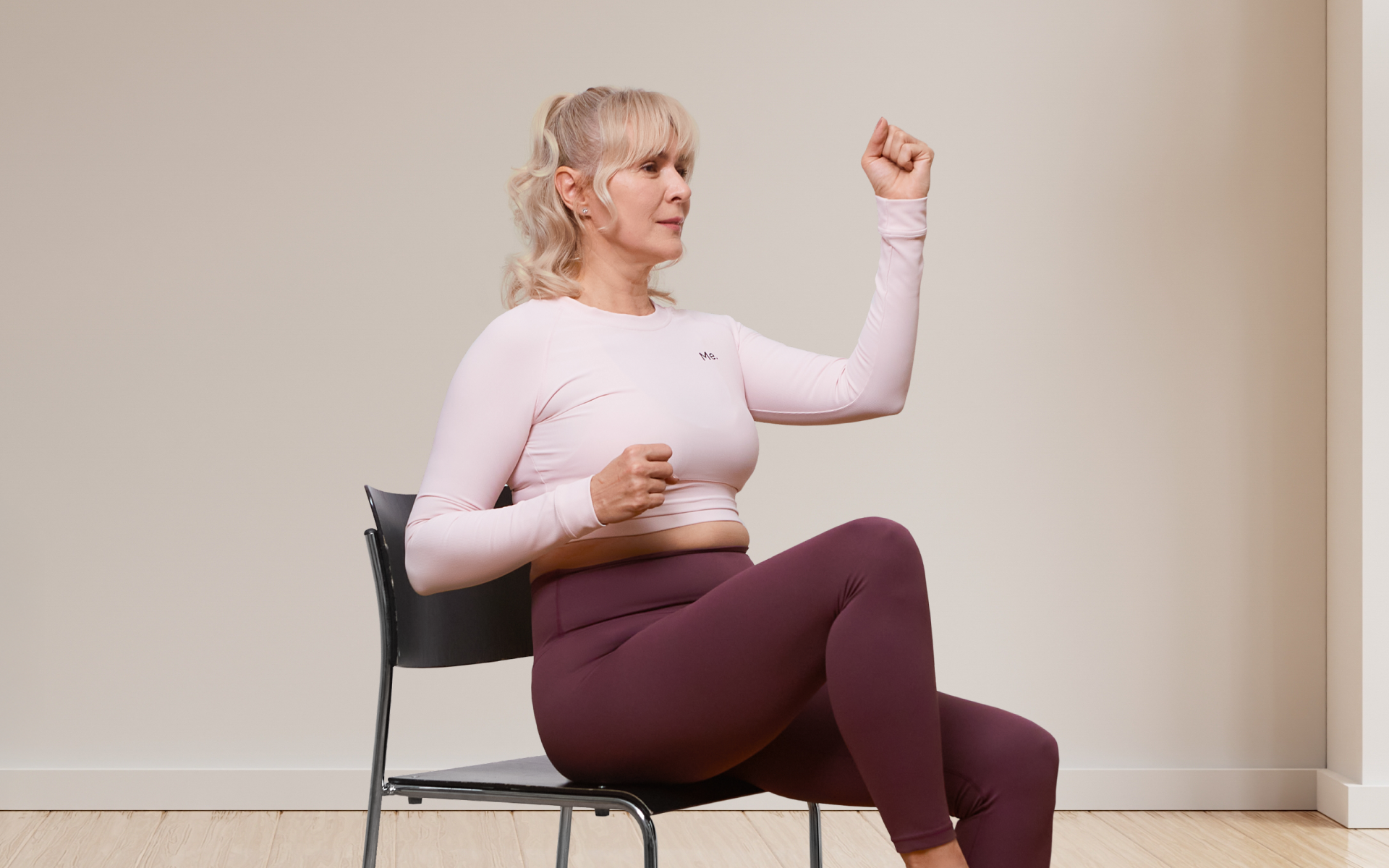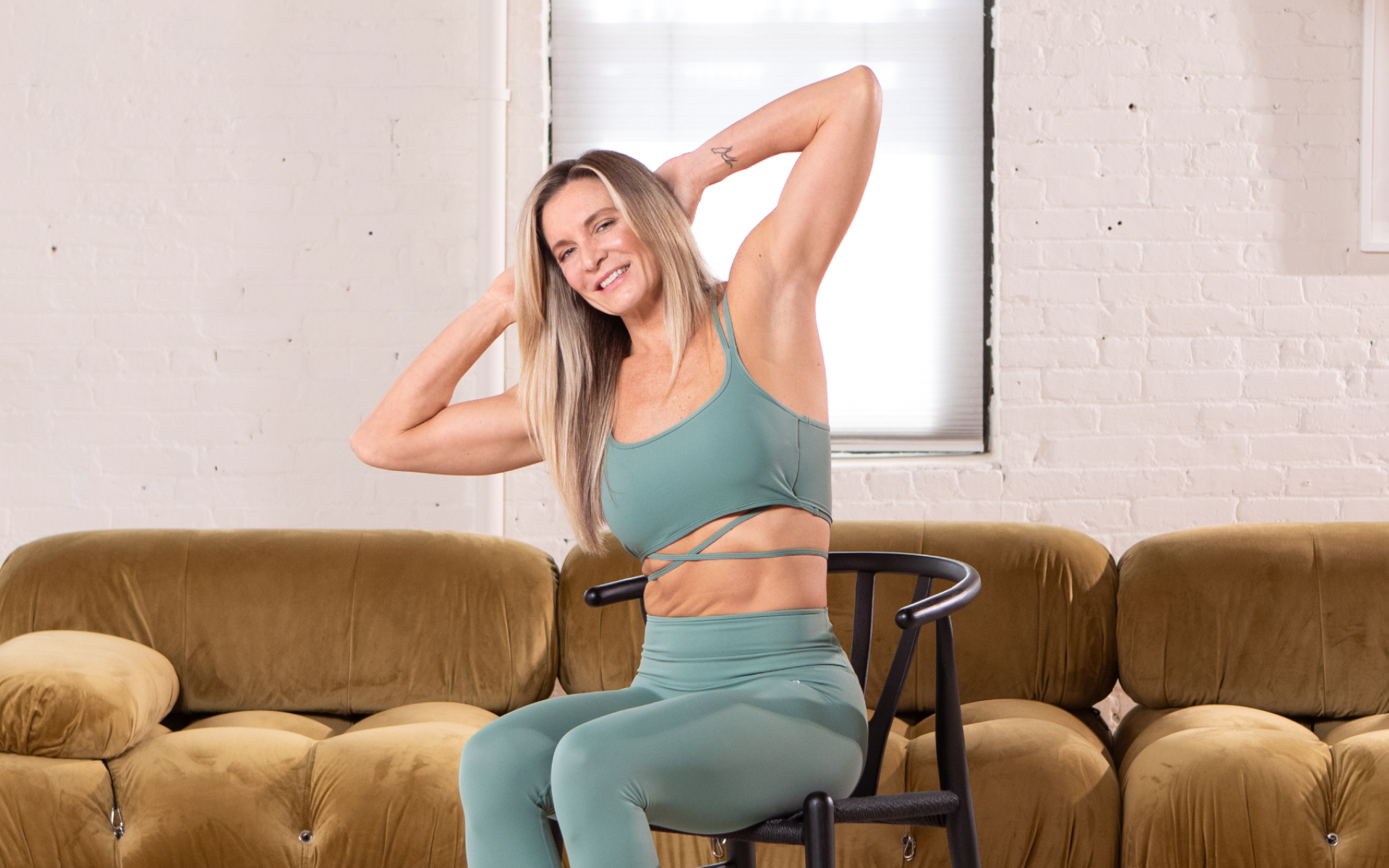Are you here looking for ways to strengthen your core and improve your endurance, even with your busy schedule? Are you unable to do the conventional core strengthening exercises that require higher fitness levels?
Well, this chair core workout plan might be just what you need!
A strong core is not only important for physical appearance but also plays a significant role in our overall health and daily activities. A strong core can help improve postural control, reduce back pain, and prevent injuries. Additionally, a strong core is essential for stability and balance, which are crucial for everyday movements like walking or carrying groceries (1).
In this guide, we will walk you through 8 chair core exercises that will help you build strength and endurance in your core muscles, from the comfort of your own chair.
Can You Do Core Exercises In A Chair?
You can effectively exercise your core while sitting in a chair, which is a fantastic option for those who may not have the time or space for a traditional workout.
While it may not seem like the most conventional way to work out, chair core exercises can be just as effective as traditional core exercises, offering a unique approach to fitness that fits seamlessly into your day.
These exercises target the abdominal muscles, back muscles, and hip flexors to build strength and stability. They can be easily modified for different fitness levels, making them accessible for everyone of all fitness levels.
Adding chair core exercises to your daily routine will allow you to sneak in some core strengthening movements, without needing to carve out additional time for a workout. This means you can enhance your fitness levels and improve your posture, all while going about your regular activities.
Do Sitting Abs Work?
Sitting Abs are very effective when performed correctly and consistently. Many people may have the misconception that sitting down while exercising is not as effective as standing up or using equipment, but this is not always the case.
Sitting Abs are exercises that are performed while sitting down, usually on a chair or bench. They specifically target the abdominal muscles, including the rectus abdominis, transverse abdominis, and obliques. These exercises can also engage other muscle groups such as the hip flexors and quads.
One of the main benefits of Sitting Abs is that they can be done anywhere at any time – at home, in the office or even while traveling. This makes it an accessible form of exercise for those with busy schedules.
In addition, sitting exercises may be better tolerated by those with significant back pain or mobility issues, compared to traditional floor exercises. Furthermore, Sitting Abs can help improve postural control and promote better balance and stability.
To see effective results it is essential to perform sitting ab exercises with proper form and technique. It’s also important to incorporate a variety of exercises to target all areas of the core for an overall strong and balanced midsection.
Whether you’re looking to simply pep up your fitness routine, jazz up your diet with mouth-watering low-calorie recipes or want to get your act together and significantly drop that number on your scale – BetterMe: Health Coaching app has got you covered! Improve your body and revamp your life!
How Can I Strengthen My Core While Sitting?
Strengthening your core while sitting can be achieved by performing targeted exercises that engage the muscles in your abdomen and lower back. These movements are designed to be performed while sitting down, making them perfect for individuals with limited mobility.
These 8 chair core exercises are perfect for those with a busy lifestyle, as they can be done at any time throughout the day.
1. Chair Crunches
Chair crunches are a great way to engage your abdominal muscles with no additional setup. This exercise primarily focuses on strengthening the rectus abdominis but will also engage the hip flexors.
Steps:
- Sit up straight in a sturdy chair with your feet flat on the floor.
- Place your hands behind your head, keeping your elbows wide.
- Tighten your core muscles as you lean back slightly in the chair.
- Engage your abs to lift your torso forward towards your knees.
- Exhale as you reach the top of the movement, then slowly lean back to the starting position.
- Repeat the movement for 10-15 repetitions.
2. Seated Knee to Elbows
The seated knee to elbows exercise primarily targets your obliques while also engaging the rectus abdominis and hip flexors.
Steps:
- Sit upright in a sturdy chair with your feet flat on the ground.
- Place your hands behind your head, maintaining an open chest.
- Lift your right knee towards your right elbow while twisting your torso.
- Bring the knee and elbow closer together, squeezing your core.
- Return to the starting position and repeat, alternating sides.
- Perform 10-15 repetitions on each side.
3. Chair Leg Raises
Chair leg raises primarily target your lower rectus abdominis, but they also play a crucial role in engaging the hip flexors and quads, both of which are highly important muscle groups of the lower body.
Steps:
- Sit at the edge of your chair with your back straight and feet flat on the floor.
- Place your hands on either side of the chair for support.
- Extend one leg out in front of you, keeping it straight.
- Raise your leg to hip height while squeezing your core.
- Lower your leg back to the floor without letting your foot touch the ground.
- Complete 10-15 repetitions, then switch to the other leg.
4. Seated Knee Tucks
Much like the chair crunches outlined above, seated knee tucks involve activation of the rectus abdominis and hip flexors.
Steps:
- Sit on a sturdy chair with your feet flat and hands at your sides.
- Lean back slightly while keeping your back straight.
- Bring your knees up towards your chest while leaning forward slightly.
- Grab your knees with your hands and hold for a moment.
- Slowly lower your feet back down to the starting position.
- Do this movement for 10-15 repetitions.
Read more: The Ultimate Home Pilates Workout Guide: Strengthen Your Core Without Leaving Home
5. Chair Flutter Kicks
Chair flutter kicks are a dynamic exercise that targets the lower abdominal muscles and hip flexors. This movement involves continuous muscle activation, which promotes muscular endurance..
Steps:
- Sit at the edge of a sturdy chair with your back straight and feet flat on the floor.
- Place your hands at your sides for support or hold onto the sides of the chair.
- Lift both legs slightly off the ground, keeping them straight.
- Alternate kicking your legs up and down in a fluttering motion, about 6 to 12 inches from the ground.
- Continue this movement for 20-30 seconds while maintaining tight control of your core muscles.
6. Chair Leg Circles
This exercise involves making circular movements with your legs while keeping an active core. This movement effectively challenges your core and lower body muscular endurance and coordination. Chair leg circles also target the hip flexors, enhancing mobility in your lower body while providing a great core workout.
Steps:
- Sit at the edge of a chair with your back straight and feet flat on the ground.
- Extend one leg out in front of you, keeping it straight.
- Begin making small circles with your extended leg, ensuring your core is engaged to stabilize your torso.
- Complete 10-15 circles in one direction, then switch to the opposite direction.
- Repeat the movement with the other leg.
7. Seated Russian Twists
Seated Russian twists enhance core strength and improve rotational stability, which is crucial for daily functional movements. This exercise also engages your obliques, helping to shape and tone your waistline.
Steps:
- Sit on a sturdy chair with your feet flat on the floor and your back straight.
- Lean back slightly while keeping your core tight.
- Place your hands together in front of your chest, elbows bent.
- Twist your torso to the right, bringing your hands alongside your hip.
- Return to the center and twist to the left.
- Alternate sides for 10-15 repetitions.
8. Chair V-Sit Hold
The chair V-sit hold is an excellent way to build endurance in your core muscles while also improving your sitting balance. This static hold challenges your stability, encouraging a strong foundation for other movements.
Steps:
- Sit towards the edge of a sturdy chair with your back straight and feet flat on the floor.
- Lean back slightly while lifting your legs off the ground, keeping them straight.
- Hold your arms out in front of you for balance or keep them by your sides.
- Maintain this position for 15-30 seconds, keeping your core engaged.
- Gradually increase your hold time as you build strength.
Integrating these additional chair exercises into your routine will not only diversify your workout but also continue to build the essential strength and endurance of your core, all while remaining accommodating to any busy lifestyle.
In our article, Chair Yoga Push-Ups, we discussed safe and low impact push up variations.
Want to spring-clean your diet, skyrocket your self-confidence, and shatter your insecurities? Check out the BetterMe: Health Coaching app and set this plan in motion!
How Can I Flatten My Stomach Sitting In A Chair?
Flattening your stomach while sitting in a chair involves a combination of targeted exercises designed to engage and strengthen your core muscles. By incorporating movements such as seated leg raises, pelvic tilts, and seated twists, you can effectively work on your abdominal muscles even while working at your desk.
It is important to note that while these exercises can help to strengthen and define your abdominal muscles, they will not specifically target or eliminate fat in that area. Having a flat stomach means having a low body fat percentage.
This is primarily achieved through diet, with exercise acting as an assistant for increased caloric expenditure. Fat reduction occurs when an individual consistently achieves a caloric deficit (expending more calories than are consumed). Body fat percentage will decrease in a relatively even distribution throughout the body, though the exact distribution of fat loss is dependent on variables such as your body type and genetics.. Incorporating chair exercises into your daily routine can be an effective way to work on your core strength and improve postural awareness and control, possibly leading to improved muscular appearance once your body fat is at a healthy level.
In addition to targeted chair exercises, you can also incorporate small lifestyle changes such as standing up and stretching regularly throughout the day, avoiding prolonged periods of sitting, and avoiding prolonged postures while seated.
These habits can all contribute to a stronger core and overall better health. So even if you spend most of your day sitting in a chair, with consistency and dedication, you can still work towards achieving a flatter stomach. Remember that it takes time and effort to see results.
Our, Chair Yoga Belly Fat might be a good place to start.
FAQs
Is Chair Pose Good for Abs?
Chair pose can be highly beneficial for your abdominal muscles. As you hold this position, your core engages actively to maintain balance and stability, which is crucial for executing the pose effectively. This engagement not only helps to strengthen your abs but also contributes to improved posture and alignment throughout your body (2).
By focusing on your breath and maintaining proper form, you can enhance the effectiveness of the pose, making it a great addition to your workout routine. Additionally, practicing chair pose regularly can help build endurance in your lower body while promoting stability in your hips and legs, ultimately leading to a more well-rounded fitness regimen.
We discussed beginner friendly yoga poses in our previous blog Easy Chair Yoga Poses.
Are Chair Crunches Good?
Chair crunches are an effective way to target your abdominal muscles, while providing support for your back. This exercise is particularly beneficial for those who may struggle with traditional floor crunches, as the chair helps to stabilize the body and alleviate pressure on the spine.
By allowing you to better isolate your core during the movement, chair crunches enable you to focus on engaging your abdominal muscles more effectively.
Additionally, they can be easily incorporated into a variety of workout routines, whether at home or in the gym, making them a versatile option for anyone looking to strengthen their core without needing to get down on the floor.
Is 100 Sit-Ups a Day Enough for Abs?
While doing 100 sit-ups a day can help strengthen your core, it’s important to remember that variety is key. Achieving visible abs usually requires a well-rounded approach that includes a balanced diet and cardiovascular exercise to reduce body fat. Simply doing sit-ups alone may not yield the results you’re looking for.
Do Sit-Ups Hit All Abs?
Sit-ups primarily engage the upper abdominal muscles, making them a popular choice for core workouts. However, they don’t fully target the lower abs nor the obliques, which are also crucial for a well-rounded core. To effectively strengthen your entire core, it’s best to incorporate a diverse mix of exercises that focus on different muscle groups.
For instance, planks help build stability and endurance in the entire core, while leg raises specifically target the lower abdominal region and hip flexors.
Bicycle crunches activate both the rectus abdominis and obliques, promoting rotational strength. By integrating these various exercises into your routine, you can achieve a stronger, more balanced core that supports overall fitness and athletic performance.
Do Planks Build Abs?
Planks are excellent for building core strength and stability, essential components for achieving stronger abs. When performed correctly, they engage multiple muscle groups, including the transverse abdominis, rectus abdominis, and even the shoulders and back (3).
This full-body engagement not only helps in sculpting the abdominal area but also enhances overall stability, which is crucial for various physical activities and sports.
Planks can be easily modified to suit different fitness levels, making them accessible for beginners while still providing a challenge for advanced athletes.
Adding planks into your workout routine can significantly improve your functional strength and contribute to better postural control and injury prevention, making them one of the most effective exercises for comprehensive core development.
The Bottom Line
Adding chair exercises into your daily routine can be a game-changer for enhancing core strength and building endurance, especially for those with sedentary lifestyles.
By consistently practicing a variety of movements, you can work towards achieving a stronger core during the normal flow of your day. Remember that while chair core exercises are an effective way to integrate some light exercise and postural variability into your day, they are not enough to provide the recommended levels of physical activity. Make sure you are incorporating other forms of exercise into your life, as well as a balanced and healthy diet. Patience and dedication are vital; results will come with time.
So, embrace these practical exercises, and make small lifestyle adjustments to support your fitness journey. With these strategies, you can effectively transform your chair into a powerful tool for developing core stability and strength, ultimately leading to better overall health and well-being.
DISCLAIMER:
This article is intended for general informational purposes only and does not serve to address individual circumstances. It is not a substitute for professional advice or help and should not be relied on for making any kind of decision-making. Any action taken as a direct or indirect result of the information in this article is entirely at your own risk and is your sole responsibility.
BetterMe, its content staff, and its medical advisors accept no responsibility for inaccuracies, errors, misstatements, inconsistencies, or omissions and specifically disclaim any liability, loss or risk, personal, professional or otherwise, which may be incurred as a consequence, directly or indirectly, of the use and/or application of any content.
You should always seek the advice of your physician or other qualified health provider with any questions you may have regarding a medical condition or your specific situation. Never disregard professional medical advice or delay seeking it because of BetterMe content. If you suspect or think you may have a medical emergency, call your doctor.
SOURCES:
- Why do we need a strong core? (2023,getactive.vic.gov.au)
- Benefits of Utkatasana (Chair Pose) and How to Do it By Dr. Himani Bisht (2024,pharmeasy.in)
- Why You Should Start Doing Planks (2021,cleveland.org)




